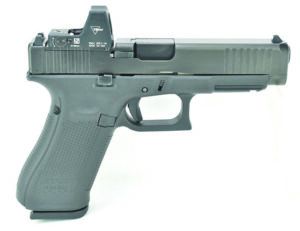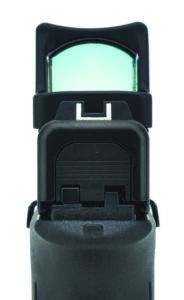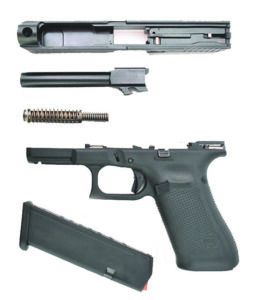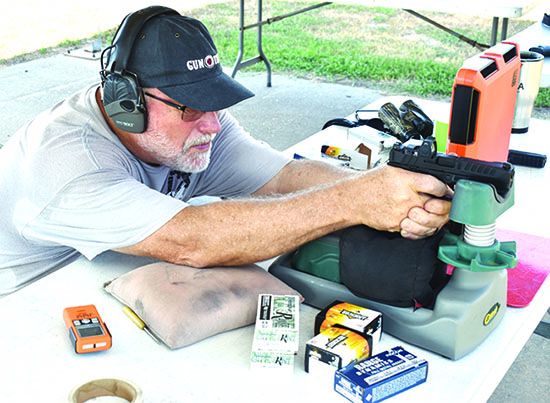Most of the law-enforcement officers on the street must face their challenges with nothing more than their training, experience, courage and the handguns on their hips. Those pistols have to go bang every time, and they have to hit what they are pointed at. Glock stills rules a large part of that world with their simplicity, ruggedness, and competitive price. The company has maintained that position by listening to its customers and by issuing successive generations of Glock Perfection, each bringing incremental improvements to the platform.
We grabbed one of the company’s latest versions, the Glock Model 47 PA475S204MOS, $629, which has most of the components set up to allow them to interchange with other similarly-sized Glocks. Our test piece has the slide cut for their Modular Optical System, or MOS.
Our second test item is the SIG Sauer P320 RX 320F-9-B-RXP, $880, which includes the Romeo 1 Pro sight. A strong contender for the LEO market, this pistol is very similar to the winner of the Army’s recent MHS (Modular Handgun System) competition, using the same serialized Fire Control Unit and many of the same parts. We grabbed one of the latest models with the full-length frame, a dust cover long enough to hang just about any light on, a slide already milled for optical sights, and backup sights in case the optics fail.
Our last entrant is the even newer Springfield Armory Echelon EC9459B-3D, $650. Utilizing a separate Central Operating Group, a la the SIG, the Echelon also brings interchangeable grip modules to the table. Add in a very robust optics mounting system. and we would get to see if the Echelon could keep up with the SIG P320 and the latest Glock Model 47 at the range.
Both the Glock 47 and the Springfield Armory Echelon were shot using a Trijicon RMR Reflex sight (RM01-C-700600, $478). The model of the SIG P320 we chose comes with a SIG Sauer Romeo 1 Pro, $358, already mounted. Here’s what we found:
Glock Model 47 PA475S204MOS 9mm Luger
$630
Gun Tests grade: A-
While not earth shattering, the incremental improvements designed into the Glock 47 make an already very good platform even better. If you like your Glock 17 (or your 19 or 45 for that matter), do yourself a favor and take a good look at the new Model 47.

| Action Type | Semi-auto, striker fired |
| Overall Length | 7.9 in. |
| Overall Height w/o optics | 5.25 in. |
| Overall Height w/optics | 6.0 in. |
| Maximum Width | 1.31 in. |
| Weight Unloaded | 1.4 lbs. |
| Weight Loaded | 2.1 lbs. |
| Slide Material | Stainless steel |
| Slide Retraction Effort | 16.2 lbs. |
| Receiver Material | Polymer |
| Finish | Tenifer |
| Front Strap Height | 2.7 in. |
| Back Strap Height | 3.5 in. |
| Barrel Length | 4.5 in. |
| Grip Thickness (Maximum) | 1.28 in. |
| Grip Circumference | 5.75 in. |
| Magazines | (3) 17-round |
| Rear Sight | White outline, drift adjustable |
| Front Sight | One white dot fixed |
| Sight Radius | 6.1 in. |
| Trigger Pull Weight | 5.8 lbs. |
| Trigger Span | 2.8 in. |
| Safety | Striker, trigger |
| Warranty | 1-year limited for original owner |
| Telephone | (770) 432-1202 |
| Website | US.Glock.com |
| Made In | Austria |
Since its first issuance in 1982, the Glock platform has morphed through five generations of improvements in their search for perfection. Aficionados can tell the version they are handling by the various changes. Sights (especially the front) on the newer models are more secure. Grip texture has seen several different levels of abrasion. The grip itself has changed dimensions for the better, and the finger grooves are no more. The most recent upgrades allow for the easy mounting of optical sights.
Based closely on the version that won a contract with the U.S. Customs and Border Patrol, the G47 was announced to the public in 2023. We would suggest that the new Glock 47 could be considered Gen 6, even if it is not so named — and the improvements have continued. The overall shape of the slide stayed the same. Still very square and almost slab-sided, the G47 added cocking serrations to the front of the slide. While we have never used forward serrations to push the slide fully to the rear, many of us with wider hands have found that in trying to do a press check (slightly pushing the slide to the rear to verify if the chamber is loaded), doing so using the serrations at the rear of the slide leaves our hands covering part of the ejection port and making the entire exercise more difficult. Forward serrations, when pinched between the thumb and index finger (making really sure the hand is to the rear of the muzzle) obviates that problem. Glock also beveled the muzzle end of the slide, making holstering much easier.

That isn’t all they did to the slide. Modularity in handguns is the name of the game today, and Glock added some capability to their platform. The dust cover now stops short of the muzzle, leaving the bottom of the slide exposed, as we are accustomed to seeing on the Models 34 and 35. The change allows the usage of a shorter recoil-spring assembly that is also suitable for a shorter pistol. The result is a full-length Glock 17-style top end that can be substituted on late-model Glock 19 frames and vice versa. The concept isn’t new. The shooting public proved it liked shorter slides on full-length frames with their acceptance of the Colt Commander. The Glock 45 is essentially the same concept in a polymer pistol. For those who wear their EDC pistol inside the waistband, barrel length (within reason) is irrelevant. A shorter frame length, however, makes the pistol more concealable. Now, for those who are among the millions who own late-version Glock 19s, the choice is yours. You can mix and match your Glock 19/47 combo as your needs dictate.
Many of the good features of the G17 Gen 5 stayed the same. If you like the hook on the front of the trigger guard, it is still there. Glock retained the flattened polymids to provide grip texture. Adhesion was good, but not obnoxious. Southpaws are still in luck with a reversible mag catch and an ambidextrous slide release. The takedown levers still require both hands. The trigger still uses a blade-mounted safety, and pull weight at 5.8 pounds was what we expected. Not the lightest trigger in our tests, but consistent and usable. Inserts allowing the shooter to make the grip larger are included. One great change, we thought, was the magazine well. Those have been beveled for some time now, but the G47 comes flared as well, making high-speed reloads a snap.

Our G47 also retained the MOS mounting plates, which are a very good system. We obtained the No. 1 adapter set from Glock, which contains four plates that should take care of most needs. Our Trijicon RMR required the No. 2 plate from that set. Screws to mount the plate to the slide are included. We also needed 6-32 screws to mount the sight to the plate. We found that the 6-32 screws we had in our optics stash weren’t the right length (of course), and we had to get out the trusty grinder to fix that. No problem, just be aware. We are not big fans of the plastic sights that come on Glocks. While they do the job well, they are not as sturdy as we prefer, and we frequently change ours out for a set like those made by Dawson Precision. Most replacement sights, however, require a bit of free room in front of the rear sight, and that just isn’t present on MOS-equipped Glocks. No problem, we still have a great red-dot sight and a set of back-up sights if needed.
Our Team Said: Feeding and function were perfect no matter what we fed the pistol, but we would expect nothing less from a Glock. Across three different types and weights of ammunition tested for accuracy at 15 yards, the Glock 47 averaged 1.4 inches, showing a slight preference for the Armscor 124-grain JHP loads. The G47 was slowest on our speed drills, though always less than 0.15 seconds behind the winner. We felt the trigger on the other two pistols was a bit easier to manipulate quickly, and that showed up in the times. Only you can decide if a 0.15-second difference (or less) is materially significant. We noted it, but certainly didn’t feel it was a deal breaker.
| 9MM LUGER RANGE DATA | |||
| Remington 115-grain FMJ | Glock Model 47 | SIG Sauer P320 | Springfield Armory Echelon |
| Average Velocity | 1142 fps | 1149 fps | 1157 fps |
| Muzzle Energy | 333 ft.-lbs. | 337 ft.-lbs. | 342 ft.-lbs. |
| Best Group Size | 1.44 in. | 1.19 in. | 1.23 in. |
| Average Group Size | 1.75 in. | 1.43 in. | 1.42 in. |
| Armscor 124-grain JHP | Glock Model 47 | SIG Sauer P320 | Springfield Armory Echelon |
| Average Velocity | 1127 fps | 1164 fps | 1162 fps |
| Muzzle Energy | 350 ft.-lbs. | 373 ft.-lbs. | 372 ft.-lbs. |
| Best Group Size | 1.03 in. | 0.69 in. | 1.16 in. |
| Average Group Size | 1.17 in. | 1.17 in. | 2.06 in. |
| Fiocchi 147-grain FMJ | Glock Model 47 | SIG Sauer P320 | Springfield Armory Echelon |
| Average Velocity | 952 fps | 960 fps | 978 fps |
| Muzzle Energy | 296 ft.-lbs. | 301 ft.-lbs. | 312 ft.-lbs. |
| Best Group Size | 1.03 in. | 0.82 in. | 0.90 in. |
| Average Group Size | 1.27 in. | 0.92 in. | 1.24 in. |
How we tested: We conducted our tests at American Shooting Centers in Houston. At 15 yards, we fired multiple five-shot groups for accuracy by shooting from a well-sandbagged Caldwell Pistolero shooting rest (MidwayUSA.com 517357, $28) assisted by a Mini DRC Fortune Cookie from Wiebad.com ($75, #MINIFC). We also wanted to test practical accuracy, so we did two additional tests. The first used 3-by-5-inch stickies attached to paper targets 8 yards downrange. We recorded first-shot times using 115-grain ammo. Then we shot controlled pairs (two sights with two sight pictures) also at 8 yards and using the same 3-by-5-inch targets. The third was a single shot on an A Zone plate (5-by-11 inches) at 32 yards. Start position on all drills was from the low ready. We used a LabRadar (MyLabRadar.com, $559) to obtain velocities using three different types of ammunition. The first was Remington Range 115-grain full-metal-jacket rounds. Then we tried Armscor 124-grain FMJs and some heavier-weight bullets using the Fiocchi Range Dynamics 147-grain FMJs.
| DRILL NO. 1 DATA | |
| Pistol | Single Shot Average Time |
| Glock Model 47 | 0.93 |
| SIG Sauer P320 | 0.82 |
| Springfield Echelon | 0.89 |
Process: Fire one shot from low ready at 3-by-5-inch card placed at 15 yards. Numbers are averages for eight repetitions. Times are in seconds.
| DRILL NO. 2 DATA | |||
| Pistol | 1st Shot | Split Average | Total Time |
| Glock Model 47 | 1.01 | 0.21 | 1.22 |
| SIG Sauer P320 | 0.92 | 0.178 | 1.098 |
| Springfield Echelon | 0.86 | 0.183 | 1.043 |
Process: Fire two shots from low ready at 3-by-5-inch card placed at 8 yards. Numbers are averages for four repetitions. Times are in seconds.
| DRILL NO. 3 DATA | |
| Pistol | Single Shot Average Time |
| Glock Model 47 | 1.27 |
| SIG Sauer P320 | 1.12 |
| Springfield Echelon | 1.26 |
Process: Fire one shot from low ready at 5-by-11-inch A-Zone target placed at 32 yards. Numbers are averages for four repetitions. Times are in seconds.
Written and photographed by Joe Woolley, using evaluations from Gun Tests Team members. GT






























